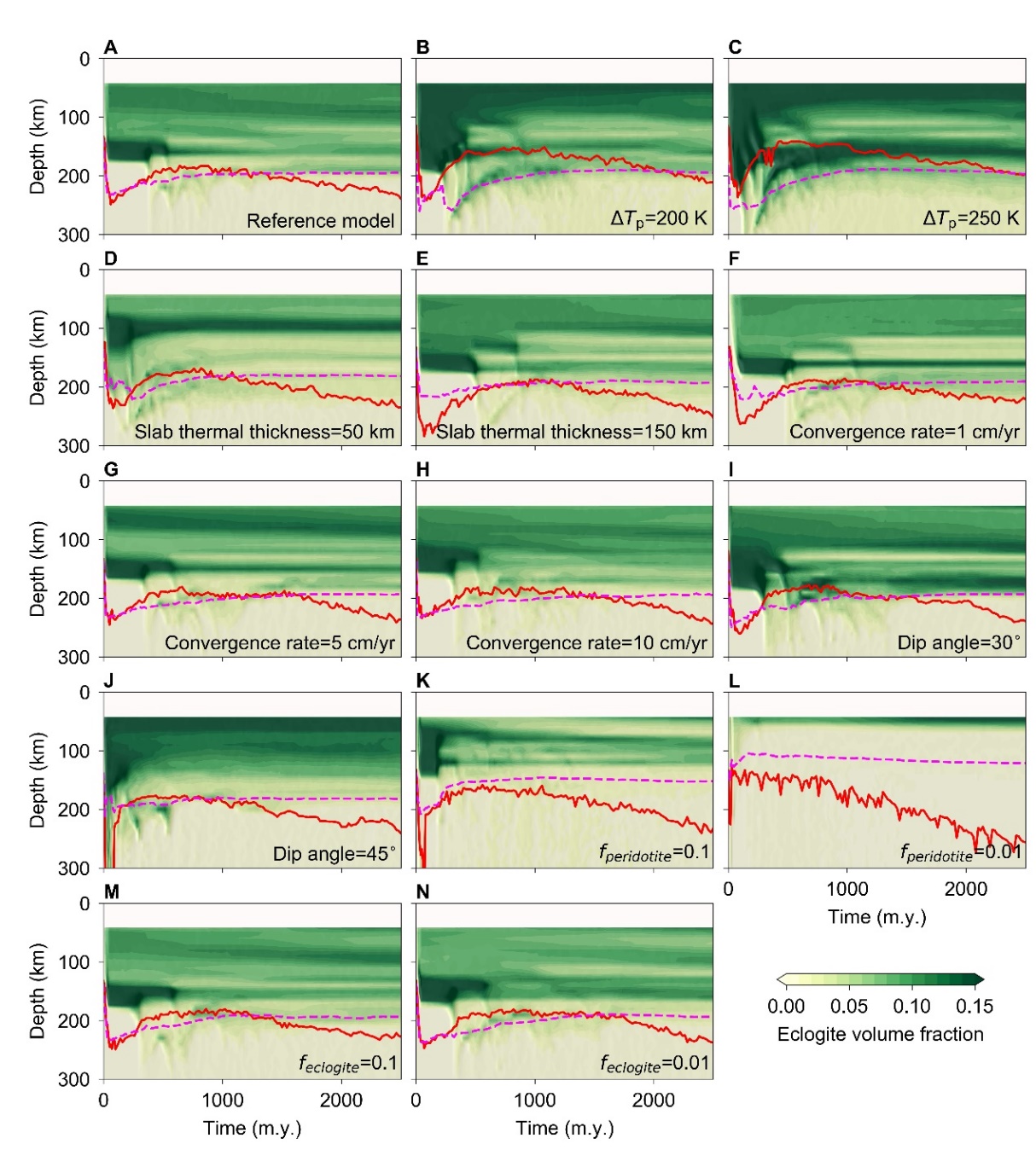91755213-Geology:数值模拟解决克拉通岩石圈俯冲叠置成因假说的榴辉岩去向之谜
古老的克拉通岩石圈如何形成?许多证据表明克拉通岩石圈是在太古宙经历多次俯冲增生事件后的板片叠置而成的。但是太古宙地幔温度更高,因此相对显生宙而言,俯冲板片中包含的洋壳更厚,俯冲到>70km深处之后会相变为密度极高的榴辉岩。这部分榴辉岩流变强度和密度与周围低密度的克拉通岩石圈性质存在很大差异,且其初始含量与克拉通岩石圈中的现存榴辉岩含量不相符,因此有人提出有很大一部分榴辉岩在俯冲过程中发生了丢失。但是榴辉岩是如何丢失的?所需时间是多久?产生的岩石圈减薄效应如何?残余的榴辉岩是多少?如何分布?缺乏动态的定量认识。
近日,中国地质大学(武汉)全球大地构造中心主任Timothy Kusky教授带领的团队通过新的地球动力学数值模拟,探讨和回答了这些问题。研究成果在2022年2月25日发表在地质学著名期刊《Geology》,文章第一作者为中国地质大学(武汉)地质过程与矿产资源国家重点实验室王振胜副研究员,共同通讯作者为Timothy Kusky教授。
研究结果表明,当俯冲形成的部分洋壳榴辉岩密度大于周围物质,即可在重力分异的驱动下,以缓慢粘性排出的方式离开岩石圈并进入软流圈。而另一部分残留的洋壳榴辉岩,如果大小合适,则可以长期保存在克拉通岩石圈地幔内,约占岩石圈地幔总体积的10%左右,与卡普瓦尔和苏必利尔克拉通的地质和地球物理观测结果一致。该研究发现长期保存的榴辉岩主要呈现两种分布形式:一种保持原始的大洋岩石圈板片俯冲叠置的原始几何学形态,封存于岩石圈浅部;另一种以离散状分布到岩石圈深部。


图 1. 俯冲叠置形成的榴辉岩重新分布结果与卡普瓦尔、苏必利尔克拉通的地质、地球物理实测数据对比图。上图,地球物理实测结果观察到,苏必利尔克拉通俯冲叠置形成的榴辉岩在地壳浅部呈倾斜的残余构造。下图,数值模拟结果显示榴辉岩俯冲后的重新分布状况。
本研究发现榴辉岩缓慢移除与重新分布对岩石圈的稳定性影响、以及残余榴辉岩分布的影响,受地幔温度、俯冲板片厚度、叠置角度、汇聚速率、榴辉岩和橄榄岩的弱化程度等多个参数控制。在多数情况下,榴辉岩的粘性排出对岩石圈厚度和稳定性的影响不大。当地幔橄榄岩存在弱化时,榴辉岩的排出会引起岩石圈的强烈减薄,其中化学岩石圈的减薄不可恢复,而热岩石圈的减薄可以在后期岩石圈冷却过程中恢复。这会引起克拉通岩石圈的热岩石圈厚度大于化学岩石圈厚度,从而呈现分层效应。榴辉岩的重新分布特征对地幔温度和橄榄岩弱化程度非常敏感。在岩浆上升形成洋壳过程中,通过更高程度部分熔融,地幔高温可引起洋壳厚度的增加,因此可以在榴辉岩粘性排出之后保留更多的榴辉岩。而橄榄岩的弱化作用有利于榴辉岩的粘性排出,从而使得俯冲叠置的岩石圈中保留更少的榴辉岩。

图 2 克拉通岩石圈地幔中的洋壳榴辉岩分布随时间变化受不同模型参数的控制。红色实线为热岩石圈底部边界,粉色虚线为化学岩石圈底部边界。A为参考模型,地幔潜能温度差异ΔTp=+135 K,热岩石圈厚度为100 km,汇聚速率为3 cm/yr,俯冲倾角为15°,橄榄岩粘度前置系数为1.0,B-N的每个模型只变化一个参数,其余参数与参考模型一致。
该研究解决了克拉通岩石圈的俯冲叠置成因假说中的榴辉岩演化之谜,合理解释了榴辉岩的去向、现存状态以及克拉通岩石圈的层状构造和长期稳定性,阐明了部分克拉通岩石圈的形成与板块构造体制下的俯冲作用有关,对于深刻理解地球早期构造体制、板块构造启动和克拉通岩石圈的形成具有重要意义。
文章详情:
Wang, Zhensheng, Kusky, Timothy. and Wang, Lu, 2022. Long-lasting viscous drainage of eclogites from the cratonic lithospheric mantle after Archean subduction stacking. Geology. https://doi.org/10.1130/G49793.1
Numerical simulation solves the mystery of the missing eclogite in the hypothesis of the subduction slab-stacking origin of cratonic lithosphere
How did the ancient cratonic lithosphere form? Much evidence suggests that the cratonic lithosphere is formed by the process of slab-stacking during multiple subduction and accretion events in the Archean. However, due to the higher temperature of the Archean mantle, the subducting oceanic plates contained a greater thickness of oceanic crust than in younger times, and this thick oceanic crust transformed into highly dense eclogite after subduction to >70 km. This eclogite has a large rheological and density contrast with the low-density characteristics of surrounding cratonic lithosphere, and its initial relative abundance is inconsistent with the present-day eclogitic content of cratonic lithosphere. Therefore, it is proposed that a large part of eclogite was lost during subduction. But how was eclogite lost? How long will it take? What is the lithospheric thinning effect? What is the residual eclogite? How is it distributed? These questions are answered using new numerical dynamic quantitative models, as published Feb 25 in the journal GEOLOGY.
Recently, the team led by Professor Timothy Kusky, director of the Center for Global Tectonics, China University of Geosciences (Wuhan), discussed these problems through geodynamic numerical simulation. The research results are published in the top-rated journal Geology. The first author of the article is Wang Zhensheng, associate researcher of the State Key Laboratory of Geological Process and Mineral Resources of China University of Geosciences (Wuhan), and the corresponding author is Professor Timothy Kusky.
The results show that some oceanic crust eclogites formed by subduction become so dense relative to surrounding material, that they physically separate and move through the lithosphere and enter the asthenosphere by means of slow viscous discharge driven by gravity differentiation. Some remnant parts, of appropriate size, of the oceanic crust eclogite can be preserved in the lithospheric mantle of the craton for a long time, accounting for about 10% of the total volume of the lithospheric mantle, which is consistent with the geological and geophysical observations of the Kaapvaal and Superior cratons. The study found that the long-term preserved eclogite mainly presents two distribution forms: one maintains the original subduction geometry of stacked oceanic lithospheric slabs, and is sealed in the shallow part of the lithosphere; another part is redistributed to the deep part of the lithosphere in a discrete form.


Figure 1. Comparison between the redistribution results of eclogites formed by subduction stacking and the measured geological and geophysical data of the Kaapvaal and Superior cratons. In the above figure, it is observed from the geophysical measurement results that the eclogite formed by the subduction stacking of the Superior craton presents an inclined residual structure in the shallow part of the crust. In the figure below, the numerical simulation results show the redistribution of eclogite after subduction.
It is found that the influence of the slow removal and redistribution of eclogites on the stability of the lithosphere and the distribution of residual eclogites is controlled by many parameters, such as mantle temperature, subduction plate thickness, stacking angle, convergence rate, and weakening degree of eclogites and peridotites. In most cases, the viscous discharge of eclogites has little effect on the thickness and stability of the lithosphere. When the local mantle peridotite is weakened, the discharge of eclogite will cause strong thinning of the lithosphere, in which the thinning of the chemical lithosphere cannot be restored, while the thinning of the thermal lithosphere can be restored during the later lithospheric cooling process. This will cause the thickness of the thermal lithosphere of the cratonic lithosphere to be greater than that of the chemical lithosphere, resulting in the delamination effect. The redistribution characteristics of eclogites are very sensitive to mantle temperature and the weakening degree of peridotite. The high temperature of the mantle can increase the thickness of the oceanic crust through higher degrees of partial melting during initial upwelling to create the oceanic crust, so more eclogites can be retained after the viscous drainage of eclogites. The weakening of peridotite is conducive to the viscous discharge of eclogite, so that less eclogite is retained in the lithosphere formed by subduction stacking.

Fig. 2 the distribution of oceanic crust eclogites in the lithospheric mantle of craton is controlled by different model parameters over time. The red solid line is the bottom boundary of the thermal lithosphere, and the pink dotted line is the bottom boundary of the chemical lithosphere. A is the reference model, mantle potential temperature difference Δ TP = + 135 K, the thickness of thermal lithosphere is 100 km, the convergence rate is 3 cm / yr, the subduction dip angle is 15 °, the viscosity pre coefficient of peridotite is 1.0, each model of B-N changes only one parameter, and the other parameters are consistent with the reference model.
This study solves the mystery of eclogite evolution in the hypothesis of subduction stacking genesis of cratonic lithosphere, reasonably explains the whereabouts and existing state of eclogite, as well as the layered structure and long-term stability of cratonic lithosphere, and expounds that the formation of some cratonic lithosphere is related to subduction under plate tectonic regime, which is important for a deep understanding of the early tectonic regime of Earth, the initiation of plate tectonics and the formation of cratonic lithosphere.
Article information:
Wang, Zhensheng, Kusky, Timothy. and Wang, Lu, 2022. Long-lasting viscous drainage of eclogites from the cratonic lithospheric mantle after Archean subduction stacking. Geology. https://doi.org/10.1130/G49793.1
.png)
